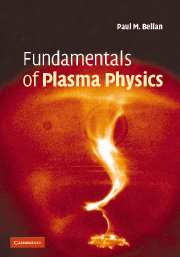Book contents
- Frontmatter
- Contents
- Preface
- 1 Basic concepts
- 2 The Vlasov, two-fluid, and MHD models of plasma dynamics
- 3 Motion of a single plasma particle
- 4 Elementary plasma waves
- 5 Streaming instabilities and the Landau problem
- 6 Cold plasma waves in a magnetized plasma
- 7 Waves in inhomogeneous plasmas and wave-energy relations
- 8 Vlasov theory of warm electrostatic waves in a magnetized plasma
- 9 MHD equilibria
- 10 Stability of static MHD equilibria
- 11 Magnetic helicity interpreted and Woltjer–Taylor relaxation
- 12 Magnetic reconnection
- 13 Fokker–Planck theory of collisions
- 14 Wave–particle nonlinearities
- 15 Wave–wave nonlinearities
- 16 Non-neutral plasmas
- 17 Dusty plasmas
- Appendices
- Bibliography and suggested reading
- References
- Index
2 - The Vlasov, two-fluid, and MHD models of plasma dynamics
Published online by Cambridge University Press: 05 June 2012
- Frontmatter
- Contents
- Preface
- 1 Basic concepts
- 2 The Vlasov, two-fluid, and MHD models of plasma dynamics
- 3 Motion of a single plasma particle
- 4 Elementary plasma waves
- 5 Streaming instabilities and the Landau problem
- 6 Cold plasma waves in a magnetized plasma
- 7 Waves in inhomogeneous plasmas and wave-energy relations
- 8 Vlasov theory of warm electrostatic waves in a magnetized plasma
- 9 MHD equilibria
- 10 Stability of static MHD equilibria
- 11 Magnetic helicity interpreted and Woltjer–Taylor relaxation
- 12 Magnetic reconnection
- 13 Fokker–Planck theory of collisions
- 14 Wave–particle nonlinearities
- 15 Wave–wave nonlinearities
- 16 Non-neutral plasmas
- 17 Dusty plasmas
- Appendices
- Bibliography and suggested reading
- References
- Index
Summary
Overview
We begin this chapter by developing the concept of conservation of particles in phase-space and then use this concept as the basis for establishing the three main models of plasma dynamics, namely Vlasov theory, two-fluid theory, and magnetohydrodynamics (MHD). The Vlasov model is the most detailed and characterizes plasma dynamics by following the temporal evolution of electron and ion velocity distribution functions. The two-fluid model is intermediate in complexity and approximates plasma as a system of mutually interacting, finite-pressure electron and ion fluids. The MHD model is the least detailed and approximates plasma as a single, finite-pressure, electrically conducting fluid. The question of which of these models to use when analyzing a given situation is essentially a matter of selecting the best tool for the task and furthermore, just as a mechanic might alternate between using a screwdriver and a pair of pliers for a specific task, it is often advantageous to alternate between these models when analyzing a specific problem. As we develop these three models, we will also take the opportunity to explore some immediate and important fundamental consequences of these models, most notably the strong dependence of a collisionless plasma on its past history (Vlasov model) and the freezing of magnetic flux into the arbitrarily moving frame of a perfectly conducting plasma (MHD).
- Type
- Chapter
- Information
- Fundamentals of Plasma Physics , pp. 34 - 74Publisher: Cambridge University PressPrint publication year: 2006
- 1
- Cited by



